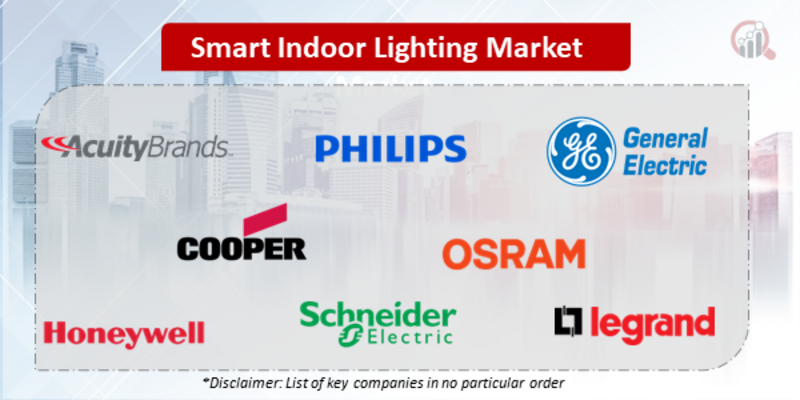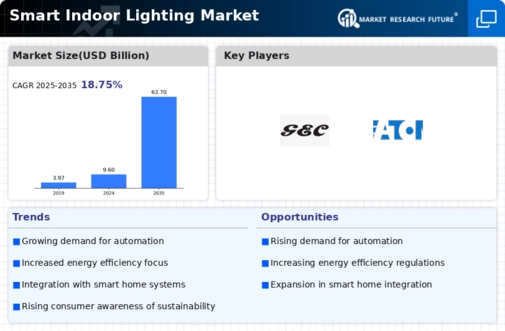Top Industry Leaders in the Smart Indoor Lighting Market

Competitive Landscape of the Smart Indoor Lighting Market
The smart indoor lighting market is experiencing a meteoric rise, fueled by a confluence of factors like rising disposable incomes, increasing energy-efficiency consciousness, and the burgeoning smart home ecosystem. This dynamic landscape presents both challenges and opportunities for players vying for market dominance. Let's delve into the competitive scene, exploring the strategies employed, factors influencing market share, new entrants, and the overall competitive scenario.
Some of the Smart Indoor Lighting companies listed below:
- Acuity Brands Lighting Inc.
- Philips Lighting
- General Electric Company
- Honeywell International
- Cooper Industries
- OSRAM Licht AG
- Legrand S.A.
- OSRAM Licht AG
- Schneider Electric SE
- Lutron Electronics Company Inc.
Strategies Adopted by Key Players:
To survive and thrive in this competitive market, players are implementing various strategies:
- Product differentiation: Companies are focusing on unique features, like biodynamic lighting, tunable white, and dynamic scene creation, to cater to specific consumer segments and stand out from the crowd.
- Partnership and acquisitions: Building partnerships with smart home platform providers and tech giants is crucial for ecosystem integration and expanding reach. Acquisitions of smaller players with niche expertise can also fuel innovation and product diversification.
- Aggressive pricing and promotional activities: Competitive pricing strategies, particularly by startups and budget-oriented brands, are attracting value-conscious consumers.
- Investment in R&D: Continuous research and development efforts are essential to stay ahead of the curve and introduce cutting-edge technology and features.
- Focus on user experience: Intuitive app interfaces, voice control integration, and seamless automation capabilities are key to enhancing user experience and fostering brand loyalty.
Market Dynamics and Growth Drivers:
The global smart indoor lighting market is experiencing explosive growth, This rapid expansion is fueled by several key factors:
- Rising energy costs: Smart lighting's ability to optimize energy consumption through automation and intelligent features is a major draw for cost-conscious consumers.
- Growing emphasis on comfort and convenience: The seamless integration with smart home ecosystems and voice assistants has enhanced user experience and convenience.
- Focus on health and well-being: Biodynamic lighting solutions promoting circadian rhythm regulation and improved sleep patterns are gaining traction.
- Technological advancements: Continuous innovations in LEDs, connectivity protocols, and AI-powered features are enhancing product capabilities and functionality.
Competitive Landscape:
The smart indoor lighting market landscape is characterized by a dynamic and diverse mix of players:
- Established industry giants: Acuity Brands, Osram, Philips, Signify (formerly Philips Lighting), and GE Lighting boast extensive research and development capabilities, brand recognition, and strong distribution networks.
- Tech giants: Amazon, Google, and Apple are entering the fray with their smart home ecosystems and voice assistants, driving integration and interoperability.
- Startups and niche players: Innovative startups like Nanoleaf, LIFX, and Sengled are pushing the boundaries with unique features, design-focused products, and competitive pricing.
- Traditional lighting manufacturers: Companies like Hubbell Lighting, Eaton, and Lutron are adapting their traditional product lines to incorporate smart features and cater to the evolving demand.
Factors for Market Share Analysis:
Analyzing market share in the smart indoor lighting market requires considering several factors:
- Product portfolio and diversity: Companies offering a wider range of products cater to various consumer needs and preferences, expanding their market reach.
- Brand recognition and reputation: Established brands with a strong legacy in the lighting industry hold an advantage in terms of trust and familiarity.
- Geographical reach and distribution channels: Companies with strong global presence and diverse distribution networks have a larger market share compared to those with limited reach.
- Pricing strategy and value proposition: Offering competitive pricing and attractive value propositions attracts cost-conscious consumers and increases market share.
- Investment in marketing and advertising: Effective marketing campaigns and brand awareness initiatives can significantly influence market share and brand recall.
New and Emerging Companies:
Several rising stars are making waves in the smart indoor lighting market:
- Nanoleaf: Renowned for its innovative modular lighting panels and dynamic scene creation capabilities.
- LIFX: Offers a range of vibrant color-changing bulbs and light strips, popular for entertainment and mood lighting.
- Sengled: Pioneering affordable smart lighting solutions with a focus on user-friendliness and accessibility.
- Circadian Optics: Leading the biodynamic lighting segment with solutions designed to support natural circadian rhythms and well-being.
- Tuya Smart: Providing smart lighting modules and platforms for third-party manufacturers, enabling rapid product development and market expansion.
Latest Company Updates:
On Oct. 25, 2023- Deako, a leading provider of modular smart lighting systems, announced a two-year exclusive contract with New Home Co. to install its modular lighting system in homes in California, Arizona, Colorado, Washington and Oregon. Deako has created the industry's first modular smart lighting system for homeowners.
New Home Co. homebuyers can upgrade their light switches through available design programs in each community. The company has also collaborated with other top builders and distributors to provide homeowners with innovative smart lighting control solutions nationwide.
On Sep. 06, 2023- Signify, a leading global lighting provider, launched a new product category with Philips Hue Secure smart cameras, sensors, and app features to help secure homes. Other updates include Philips Hue Festavia string lights for both indoors and outdoors and the launch of Matter for all Philips Hue users.
On Aug. 03, 2023- GE Lighting officially launched new smart hexagon light panels, Cync. The panels are available in a 7-pack, 10-pack, and 5-pack extension kit, featuring six segments that can be controlled separately for optimal customization. The new Cync Smart Hexagon Panels connect to Wi-Fi as a single, smart light fixture, and they are controlled with the Cync mobile app powered by Savant.
On Jun. 13, 2023- Vivint Smart Home, a leading smart home company, launched Vivint Smart Lighting, an elegant lighting solution designed to make homes safer, smarter, and more sustainable. New Smart Lighting seamlessly integrates with Vivint's industry-leading platform without any electrical work, introduces new smart home features, and provides enhanced security.









